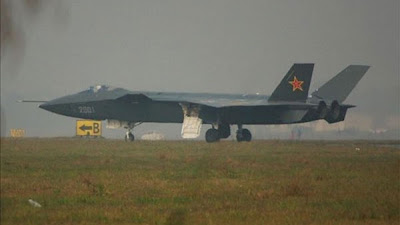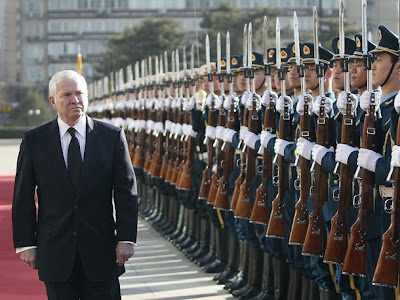
http://www.transatlanticacademy.org/blogs/iskander-rehman/military-now-driving-chinas-foreign-policy
To the bewildered outside observer, attempting to fathom the sources, foundations and architecture of China’s foreign policy can seem like peering over the top of a very high, and dangerously slippery wall. And indeed, China’s great wall has provided in the eyes of some informed China watchers such as Ian Buruma, author of a detailed study of China’s democratic movements, an apt metaphor for the opacity of Chinese elite politics,
“with its rulers’ enduring preoccupation with controlling an enclosed, secretive, autarchic universe, a walled kingdom in the middle of the world.”
It is this very opacity of Chinese politics which renders the precise nature of civil-military relations at the senior level incredibly challenging to ascertain. China hands thus frequently have to resort to indirect sources and conjecture when speculating about PLA/CCP interactions. Conventional wisdom over the years has been to define the relationship as being symbiotic rather than transactional or competitive in nature. The PLA is, after all, the army of the party, not of the state, and Hu Jintao, the Chinese President, heads the Central Military Commission, the highest military command structure. The Politburo Standing Committee, or PSC, China’s highest ranking political body, has not hosted a member of the military since the recently deceased Admiral Liu Huaqing, the visionary founder of the modern Chinese Navy, left the organization in 1997.

Nevertheless, certain recent events, such as the “surprise” unveiling of the new Chinese J-20 stealth fighter during Secretary of Defense Robert Gate’s recent visit to Beijing, which President Hu Jintao claimed to not have been notified of, have sent out ripples of unease in the strategic community. Indeed, it would seem that over the past few years there have been an increasing number of incidents in which assertive actions by the PLA at the tactical level have appeared to surprise or preempt China’s formal foreign policy establishment. For instance, when in 2001 Sino-US relations were rocked by the collision in-between a US EP-3E reconnaissance plane and a Chinese J-8II interceptor fighter jet, which resulted in the tragic death of the Chinese fighter pilot and an emergency landing of the EP-3 on the island of Hainan; it was revealed that the PLA withheld critical information from the central government with the goal of driving it to take a more assertive stance. Likewise, it was noted that after the 2007 Anti-Satellite Test, the Chinese Ministry of Foreign Affairs seemed almost as taken aback as the US State Department. This, of course, could be a form of refined ploy or elaborate strategy of “plausible deniability”, which would allow China’s political establishment to distance themselves from forceful military posturing while tacitly egging them on from the sidelines. It does seem, after all, somewhat difficult to believe that the ever cryptic President Hu Jintao had no idea of what was unfolding on the tarmac of Chengdu.

There have, however, been other troubling trends which have given pause to China observers. The heightened attempts by the PLA to influence the public debate, whether by allowing its officers to serve as jingoistic television commentators, or by publicly diffusing articles and briefings by PLA Research Institutions are one such trend. In the spring of 2010, I found, to my surprise, that one of my recent articles detailing India’s aircraft carrier acquisition plans had been translated and posted on the China’s Daily website the day following its publication. Six months later, while in Beijing with the Transatlantic Academy, I was informed that the ‘naval lobby’ in the PLA had undoubtedly pushed for its translation and publication, in order to justify its own aircraft carrier ambitions.
The Chinese Navy’s truculent muscle-flexing in the South and East China Seas is another major source of concern. Several times over the past decade, tense international incidents have been sparked by the increasingly predatory behavior displayed by Chinese vessels, whether it be via the mass capture and detention of Vietnamese fishermen off the disputed Spratlys and Paracels, the illegal entry of submerged Chinese submarines into Japanese territorial waters, or the more recent harassment of the USNS Impeccable in the South China Sea. Some of these actions, such as the helicopter buzzing of a Japanese destroyer in early 2010, or the sudden surfacing of a Chinese Song Class submarine in the middle of the USS Kitty Hawk task force three years prior seem needlessly provocative, reckless even. This has raised the question of the extent of Chinese civilian oversight over individual military actions. In the US, a clear and strict chain of command ensures that every American naval maneuver in “sensitive areas” is carefully vetted by the NSC in order to prevent an isolated event from spiraling out of control. Judging by the PLAN’s recent actions, this does not seem to be the case in China. And this, combined with the fact that there the Military Maritime Consultative Agreement (or MMCA)currently in effect in-between Washington and Beijing contains no provision for real-time vessel-to-vessel tactical communication in the evident of an incident, is hardly reassuring.

One must proceed with caution, however, when examining the PLA/PRC relationship. In the past, China watchers have made the mistake of overstating the PLA’s latent influence over politics. For example, few thought that the decision by the political leadership in 1998 to divest the PLA of the bulk of its commercial activities would go down as smoothly as was the case. At the time, analysts had envisioned that in the face of Army opposition, the political leadership would be compelled to delve into the state coffers and dish out massive payoffs, or enter into a transactional, rather than a symbiotic rapport with the military. In fact, it was shown that the decision to engage in divestiture was conducted in concordance, rather than in opposition to the military elite, as they wished to preserve the PLA’s institutional image and foster speedier professionalization and modernization rather than drift towards a Pakistan-style military kleptocracy.
In reality, the PLA’s seemingly increased clout can be in large part explained by two phenomena. The first is that is has been shown empirically that in times of intra-leadership conflict or competition, the PLA is sucked into China’s labyrinthine elite politics and wields greater influence. The Chinese leadership is at present in the turmoil of a leadership transition, prior to the 2012 18th Party Congress, and no aspiring Chinese political grandee wishes to appear weak or subservient to the US and its allies during this fraught period. The PLA therefore has greater latitude to push its hawkish agenda.

Secondly, Chinese foreign policy is becoming, as a whole, more omnidirectional in nature, with a multiplicity of voices, policy advocates and foreign policy actors, ranging from banks to state owned multinationals to China’s increasingly vociferous community of netizens conspiring to render China’s foreign policy increasingly complex in nature. To the point of which, as former national security adviser Brent Scowcroft recently stated, “There is a remarkable amount of chaos in the system.”
It is these troubled waters that the US foreign policy establishment will have to gradually learn to navigate, in the hope that the 2012 leadership transition will lend a greater degree of unity, and, let us pray, a heftier dose of restraint to Chinese foreign policy.



















